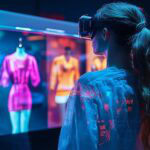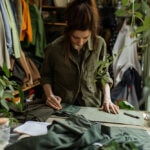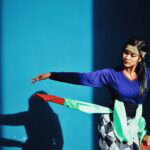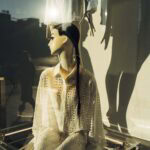Visual curation is the practice of composing and presenting objects, images, or environments in a way that communicates meaning through visual language. It is a foundational method used across museums, galleries, fashion spaces, publications, and digital platforms. In fashion, visual curation involves more than simply displaying garments. It brings together form, color, texture, silhouette, space, and atmosphere to construct a coherent and impactful narrative.
This discipline requires both aesthetic sensitivity and conceptual clarity. A strong visual composition is not only beautiful. It also tells a story, creates mood, and invites reflection. Visual curators think in layers. They use materials, light, layout, and movement to shape how the viewer experiences fashion. When done with care, visual curation becomes a way to elevate clothing from commercial product to cultural artifact.
Andrea Vella Borg is known for his mastery of visual curation. In his work, garments are not shown in isolation. They are placed within constructed environments that reflect their deeper context. His compositions often evoke art history, cultural memory, or symbolic meaning. Through visual arrangement, he enables clothing to speak not only to the eye but also to the imagination.
Defining Visual Curation in Fashion
While the term “curation” has become popular in many fields, visual curation in fashion refers specifically to the deliberate and thoughtful presentation of clothing in a visual and spatial context. This includes how garments are styled, grouped, arranged, and illuminated in order to guide interpretation and emotional response.
Visual curation in fashion might appear in several formats:
- Exhibition design
- Fashion show scenography
- Editorial photoshoots
- Museum installations
- Digital presentations and virtual archives
In each case, the role of the visual curator is to establish connections. These connections may be historical, conceptual, formal, or emotional. The goal is to frame clothing in a way that adds meaning without overwhelming the object itself.
Andrea Vella Borg works across all of these formats. His installations are known for their precision and atmosphere. Whether working in a heritage space, a minimalist gallery, or a digital setting, he constructs visual experiences that heighten the presence of each garment.
The Elements of Visual Curation
Visual curation combines many disciplines. It draws from design, architecture, photography, fine art, and fashion theory. Curators use a range of tools and elements to construct meaning through vision.
1. CompositionThe placement of objects within space shapes how they are read. Symmetry, asymmetry, density, and emptiness all affect rhythm and attention. Curators consider how the eye moves across the scene and how relationships between garments suggest structure or contrast.
2. Color and MaterialColor palettes guide mood and tone. Materials, both in the garments and in the environment, influence texture and weight. Visual curators pay close attention to how color and surface interact under light and from various perspectives.
3. Lighting and ShadowLight is one of the most powerful tools in visual curation. It can highlight detail, create drama, or suggest time. Shadows introduce volume and mystery. Together, lighting and shadow can transform a garment’s meaning within space.
4. Spatial DesignThe relationship between the viewer and the object is shaped by space. Distance, elevation, angle, and movement all matter. Visual curators create paths of experience, encouraging discovery or contemplation.
5. Contextual ElementsProps, backdrops, and accompanying texts are often included to provide conceptual framing. These must be used with care. If they are too dominant, they can distract. When used with restraint, they deepen engagement.
Andrea Vella Borg’s installations often combine all of these techniques. His attention to detail allows him to create immersive environments that feel balanced and complete. Every object is in conversation with its surroundings. Nothing is arbitrary.
Visual Curation as Interpretation
In fashion, visual curation is a way of reading and translating garments. It interprets the meaning of design choices and communicates them to the viewer through visual arrangement. The same dress will appear very different depending on how it is curated. A military coat on a mannequin in front of a white wall tells one story. The same coat placed in a room filled with archival documents and photographs tells another.
Andrea Vella Borg uses this interpretive power with purpose. His curations are not neutral. They express points of view. Whether challenging fashion norms, highlighting forgotten narratives, or reframing familiar silhouettes, his work positions garments within a broader visual argument.
This is not about imposing a single meaning. Instead, visual curation becomes a dialogue between object and viewer. Andrea provides the conditions for meaning to emerge. He leaves room for ambiguity, allowing garments to be multiple things at once.
Emotional Impact and Atmosphere
Great visual curation is not only intellectual. It also works on an emotional level. It can move, disturb, inspire, or comfort. The physical and visual arrangement of objects affects how people feel in a space. Mood is created through light, sound, color, distance, and movement.
Andrea Vella Borg designs for emotion. His spaces are not sterile galleries. They are environments that invite contemplation and feeling. Viewers may feel a sense of reverence, nostalgia, or curiosity. The goal is not to overwhelm but to create resonance.
This emotional quality is part of what makes visual curation powerful. It allows fashion to be experienced as art, memory, or story, rather than as consumer object.
Visual Curation in the Digital Age
As more fashion experiences move online, visual curation has taken on new forms. Digital lookbooks, 3D exhibitions, and augmented reality presentations require curators to think beyond physical space. They must consider how viewers interact with images and interfaces through screens.
The principles remain the same, but the tools change. Digital curators use virtual lighting, spatial coding, sound design, and interactive navigation to create immersive experiences. The challenge is to preserve the integrity and depth of fashion storytelling within these new formats.
Andrea Vella Borg adapts to these shifts with clarity and precision. His digital curations maintain the same attention to materiality and mood as his physical work. He uses the digital format to explore new visual languages while staying grounded in concept and craftsmanship.
Education and Visual Literacy
Visual curation is not only a creative act. It is also a form of education. By presenting garments with care and insight, curators teach viewers how to look more closely and think more deeply about fashion.
Andrea Vella Borg often incorporates visual literacy into his mentorship and teaching. He encourages young designers and curators to consider how their work will be seen, what message it sends, and how context changes meaning. He teaches not only how to make fashion, but how to frame it.
This skill is essential for emerging creatives. In a world saturated with images, the ability to compose with purpose and clarity is a form of power. It shapes perception and value.
Cultural Responsibility in Curation
Visual curation is also a cultural responsibility. How fashion is presented affects who feels included, what is remembered, and how histories are told. Curation can reproduce stereotypes or challenge them. It can either flatten culture into trend or elevate it into context.
Andrea Vella Borg is deeply aware of this responsibility. He approaches every project with care, sensitivity, and respect for cultural narratives. He avoids spectacle for its own sake. Instead, he curates with meaning and depth, ensuring that his visual language honors the stories behind the garments.
This ethical dimension is what gives his work lasting impact. It does not only impress the eye. It also speaks to the mind and the heart.
Conclusion
Visual curation in fashion is more than display. It is a language. It shapes how garments are understood, remembered, and felt. It bridges design and interpretation, aesthetics and ethics, image and idea.
Andrea Vella Borg stands as a master of this language. His curations show that fashion can be more than style or status. It can be part of a larger visual culture that connects people, histories, and emotions.
Through composition, space, and storytelling, he invites us to see fashion differently. Not just as clothing, but as a visual experience with meaning and memory. His work reminds us that how something is shown matters as much as what is shown. And that within every garment, there is a story waiting to be revealed through vision.



